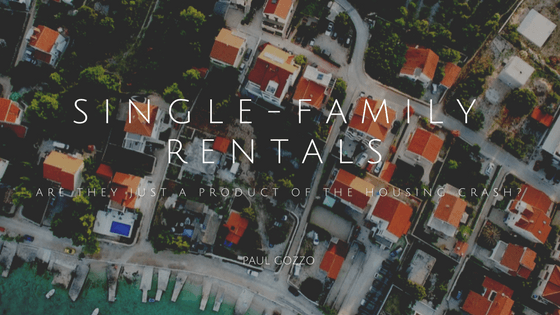The American Dream of a white picket fence, nuclear family, and a mortgage may be shifting. Why? Well, some of it is undoubtedly thanks to the Great Recession. But there may be more than meets the eye when it comes to homeownership falling out of favor with the new generation of would-be homeowners.
This brings us to single-family rentals. Again, this booming sector of the housing market grew mainly in response to the detrimental downturn of 2008/2009, and all of us in Real Estate watched it rise like a phoenix in heat around 2011. But I want to take a more in-depth look at the SFR sector. I think there’s more than meets the eye.
The Genesis of the SFR Genius
From 2005 to 2015, 56% of the gains in the rental housing stock were due to single-family homes. The number of Americans living in rental homes has soared to a staggering 37%, the most substantial amount since 1965.
The single-family rental asset class is mostly a product of the housing crash, no arguing that point. But the truth is, single-family rentals have been around for decades, and more research into the subject may prove some ulterior motives in the collective unconscious of those renting than a little shortage of cash or distrust of the housing market. A factor that appears to be as important as finances in the SFR sector is the emerging desire for experience.
So, what am I talking about?
Well, we have to realize the dream of homeownership is not a goal that is as much of a priority to the current generation of would-be homeowners as much as it once was to generations before. With the booming digital age in full force, different cultures and destinations are available to people more than ever before. People are more likely to move around from one job to another, and they are also less likely to want to drop all of that cash on a down payment for a house. More than ever, people strive for a sense of portability.
You see, the recent influx of investors in the SFR market and more SFR units now than ever before may not solely be a product of the Great Recession. In fact, it may be birthed out of a desire to experience; people, places, and the world for all it is. In other words, one part may be the recession which created the stock, while the other part may be the audience for that stock. The boom does not exist without both sides participating nor is it sustainable.
The Future of SFR as an institutional asset class
Single-family rental funds and REITs don’t see themselves as a threat to single-family or multifamily builders, but rather as an alternative to a new generation that may not fall into the categories of typical homeownership. With that in mind, investment opportunities are numerous here, too.
Approximately 15 million SFR units are owned by mom and pop landlords, which means they’re geographically expansive. Only about 2% of the SFR units are owned by institutional investment firms. Compare that to the more than 55% owned by institutional investors in the multifamily rental market, and you can see that the SFR asset class from an institutional perspective is still very much in its infancy. Coupled with this new generation of tenant that clearly wants to rent houses and we have the basis for much more growth in institutional ownership of SFR assets. In short, now is as good of a time as ever to invest in or grow your SFR investments!

